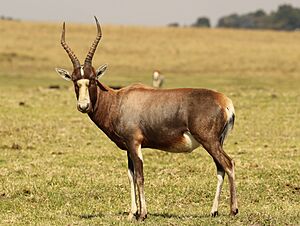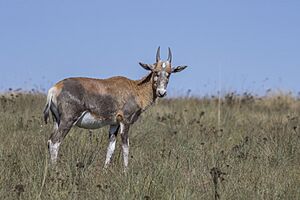Blesbok facts for kids
Quick facts for kids Blesbok |
|
|---|---|
 |
|
| At Krugersdorp Game Reserve | |
| Conservation status | |
| Scientific classification |
|
| Kingdom: | Animalia |
| Phylum: | Chordata |
| Class: | Mammalia |
| Order: | Artiodactyla |
| Family: | Bovidae |
| Subfamily: | Alcelaphinae |
| Genus: | Damaliscus |
| Species: | |
| Subspecies: |
D. p. phillipsi
|
| Trinomial name | |
| Damaliscus pygargus phillipsi Harper, 1939
|
|
| Synonyms | |
|
Damaliscus dorcas phillipsi |
|
The blesbok (also called blesbuck) is a type of antelope found only in South Africa, Eswatini, and Namibia. It is a special kind, or subspecies, of the bontebok. The blesbok has a very clear white face and forehead. This white mark gave it its name! In Afrikaans and Dutch language, "bles" means a white mark, like the one you might see on a horse's face.
Contents
What is a Blesbok?
The blesbok and the bontebok are very similar animals. They are both types of the same species. This means they can have babies together. Their mixed babies are called "bontebles" or "baster blesbok." The main reason they look a bit different is because they like to live in slightly different places in the wild.
Where Blesboks Live
Blesboks live in southern Africa. You can find many of them in national parks. They like open grasslands and plains. They do not like areas with many trees. They are found from the Highveld in the north, through the Free State, down to the Eastern Cape. When they were first discovered in the 1600s, there were huge groups of them.
Blesboks prefer open veld or plains. Their favorite home is open grassland with water nearby. They usually stay in small areas, about 2.5 to 6.0 acres big. They were once very common. But by 1893, their numbers dropped a lot. This was because people hunted them for their skins and meat. Luckily, legal hunting for trophies has helped blesboks survive. It has even helped them grow in number in some areas.
How to Spot a Blesbok
Male and female blesboks look very much alike. They can weigh up to 85 kilograms (about 187 pounds). A special thing about the blesbok is the bright white stripe on its face. This stripe is split by a brown line above its eyes.
Their bodies are mostly brown. They have a lighter brown area on their back, like a saddle. Their rump, or rear end, is even lighter. Their legs are brown, but they have a white patch behind their front legs. The lower parts of their legs are whitish. Both male and female blesboks have horns. The horns have rings almost all the way to the tip. Female horns are a little thinner.
The blesbok's neck and upper back are brown. Lower down on their sides and bottom, the color gets darker. Their belly, the inside of their legs, and the area near their tail are white. It's easy to tell a blesbok apart from other antelopes because of its distinct white face. Blesboks have less white on their bodies than bonteboks. Their face stripe is usually split, and their coat is a lighter yellow color. Their horns are about 38 centimeters (15 inches) long. Adult males weigh about 70 kilograms (154 pounds). Females are a bit lighter, around 61 kilograms (134 pounds).
- Body length: 140 to 160 centimeters (4.6 to 5.2 feet)
- Shoulder height: 85 to 100 centimeters (2.8 to 3.3 feet)
- Tail length: 30 to 45 centimeters (12 to 18 inches)
- Weight: 55 to 80 kilograms (121 to 176 pounds)
Blesbok Reproduction and Life Cycle
Blesboks breed at certain times of the year. They usually mate from March to May. Most babies are born in November and December. This is after a pregnancy of about 240 days, which is about 8 months. Female blesboks usually have one baby calf each breeding season.
Blesbok Status and Safety
Blesboks were once hunted so much that they almost disappeared. But since the late 1800s, they have been protected. Their numbers have grown a lot! Today, there are enough blesboks that they are not considered endangered. This is partly because private landowners value them. Blesboks are also one of the few medium-sized antelopes that can be kept inside normal farm fences.
In 2017, the number of blesboks was increasing. There were at least 54,000 of them. About 69% of these were purebred. At least 17,000 blesboks live in protected areas. The main concern for them now is mixing with bonteboks. This can create hybrid animals.
Who Hunts Blesboks?
Humans are one of the main hunters of blesboks. Other predators include lions, leopards, African wild dogs, spotted hyenas, and cheetahs. Smaller predators like jackals and eagles might attack young blesbok calves. People also farm and hunt blesboks for their skin, meat, and as hunting trophies.
Blesboks are shy and always alert. They use their speed and strength to run away from danger. But they often come back to the same spot after a few minutes. When chased, they can run as fast as 70 kilometers per hour (43 miles per hour). However, blesboks are not very good at jumping over things. But they are very good at crawling underneath obstacles!
Ancient Blesbok Relatives
Scientists have found old bones of a blesbok relative. This ancient animal was called Damaliscus niro. Its bones were found in Sterkfontein. This old relative weighed about 120 kilograms (265 pounds). That's heavier than today's blesbok! It also had slightly different horns. D. niro died out about 12,000 years ago, at the end of the Ice Age.




